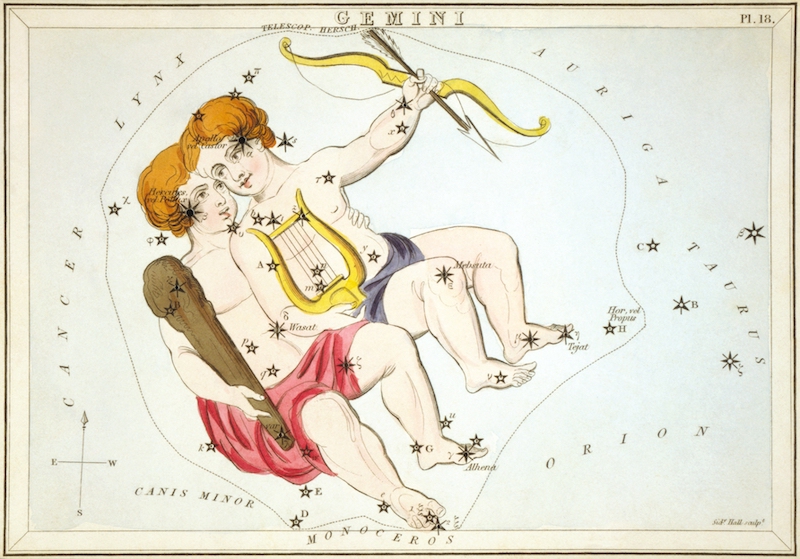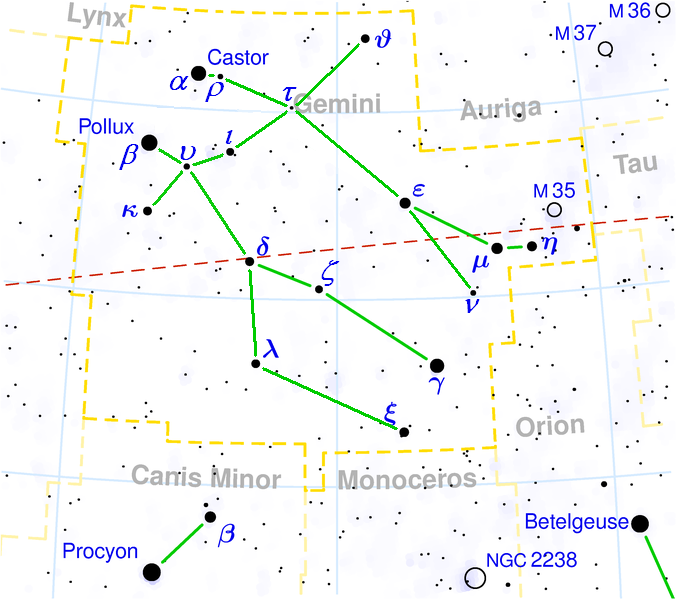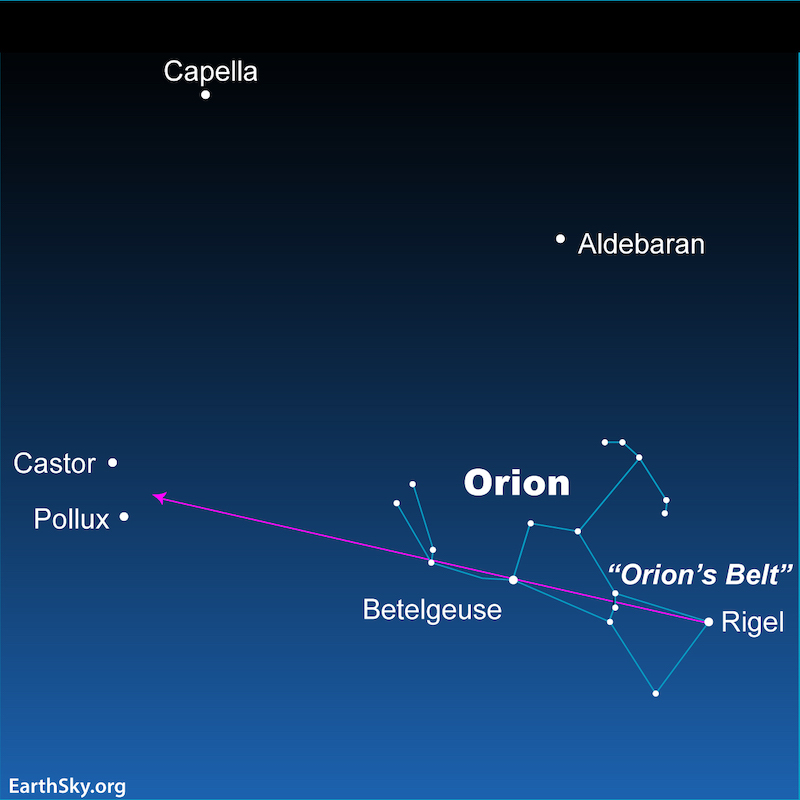How To Find Your Star Constellation

Gemini, the constellation of the Twins
Most people see the constellation Gemini as just ii bright stars – Castor and Pollux – sometimes called the Gemini twins. These ii stars aren't really twins. Pollux is brighter and more than golden in color. Castor is slightly fainter and white. Only both stars are bright, and they're noticeable for existence close together on the sky's dome. From fourth dimension immemorial, people have idea they looked like blood brother stars.

Best viewing for this constellation
January, February and March are great for observing these stars. And then Gemini is well upwards in the east at nightfall. In early February, Gemini climbs highest in the heaven around x p.thou. local fourth dimension. In late February, the constellation is highest around 9 p.m. That'south local fourth dimension, the time on your clock, no thing where you live around the earth.
Gemini stays in view in the evening heaven until around May. By belatedly May and June, Gemini is constitute low in the west at nightfall, and Gemini's two brightest stars – Brush and Pollux – fade into the sunset before the June 21 summer solstice. The sun annually passes in front of Gemini from about June 21 until July xx.
Myths and lore
In skylore, Brush and Pollux were the sons of a mortal female parent, Leda. Brush was the mortal brother, son of Tyndareus, and Pollux the immortal brother, son of Zeus. Castor and Pollux were joyfully united in spirit, yet sorrowfully divided by circumstance. When Castor was slain in boxing, Pollux was inconsolable and begged Zeus to salve him of the bonds of immortality. Zeus granted his request, and, to this day, Pollux and Castor stand reunited in the heavens, a tribute to the redemptive power of brotherly love.
Thus the Greek myth of Castor and Pollux explores the inherit duality of life, of mortality and immortality forever intertwined.

Hither's how to discover Gemini from constellation Orion
If you pick out any noticeable sky blueprint in the February night sky, that pattern has a good gamble of being the constellation Orion the Hunter. On Feb evenings, from the Northern Hemisphere, Orion is high in the s.
Orion is noticeable for its Belt stars, a short, straight row of iii medium-bright stars. Look below Orion's Chugalug for the very bright blue-white star Rigel. Meet it? At present look in a higher place Orion'southward Belt for the carmine star Betelgeuse. See that? Yous can draw an imaginary line from Rigel through Betelgeuse to locate Castor and Pollux. Remember, yous'll be looking for two bright stars that are noticeably close together.

Here'southward how to find constellation Gemini using the Big Dipper
The Big Dipper is an asterism, not a true constellation, but only a very articulate dipper-shaped design of stars. The Big Dipper is always located generally n on the sky'south dome. Draw an imaginary line diagonally through the basin of the Big Dipper, from the star Megrez through the star Merak. Yous are going in the direction reverse of the Big Dipper handle. This line will point to Castor and Pollux.

Yous can also utilize the moon to detect Gemini.
Every bit the moon swings full circumvolve through the constellations of the zodiac, it passes through Gemini for a few days each month. Cheque EarthSky Tonight – especially in the months of January, February and March – for posts showing you the moon near Castor and Pollux on specific dates. It'll happen next effectually April xviii and 19, 2021.
Or play around with the online planetarium programme, Stellarium. It can show you when the moon moves through Gemini every month (except during those months when Gemini is behind the sun).

Spotting Sirius when Gemini is high in the sky
Past the way, Gemini and nighttime's brightest star, Sirius, attain their highest points in the sky at roughly the same time. At middle latitudes in the Northern Hemisphere, we see Gemini'due south brightest stars, Castor and Pollux, nearly overhead while Sirius sparkles quite low in our southern sky. Due south of the equator, it'south the contrary: Sirius shines way up high while Gemini sits depression in the northern heaven.

Lesser line: Winter and leap are the best times to expect for the constellation Gemini in the dark sky. Castor and Pollux, the two brightest stars in Gemini, are twin brothers from Greek and Roman mythology.
Taurus? Hither's your constellation
Gemini? Here's your constellation
Cancer? Hither's your constellation
Leo? Here's your constellation
Virgo? Here's your constellation
Libra? Here'southward your constellation
Scorpius? Hither's your contellation
Sagittarius? Here's your constellation
Capricornus? Hither's your constellation
Aquarius? Here's your constellation
Pisces? Here's your constellation
Aries? Here'southward your constellation
Altogether late Nov to early on December? Here's your constellation
Source: https://earthsky.org/constellations/gemini-heres-your-constellation/
Posted by: davisinscurs36.blogspot.com


0 Response to "How To Find Your Star Constellation"
Post a Comment